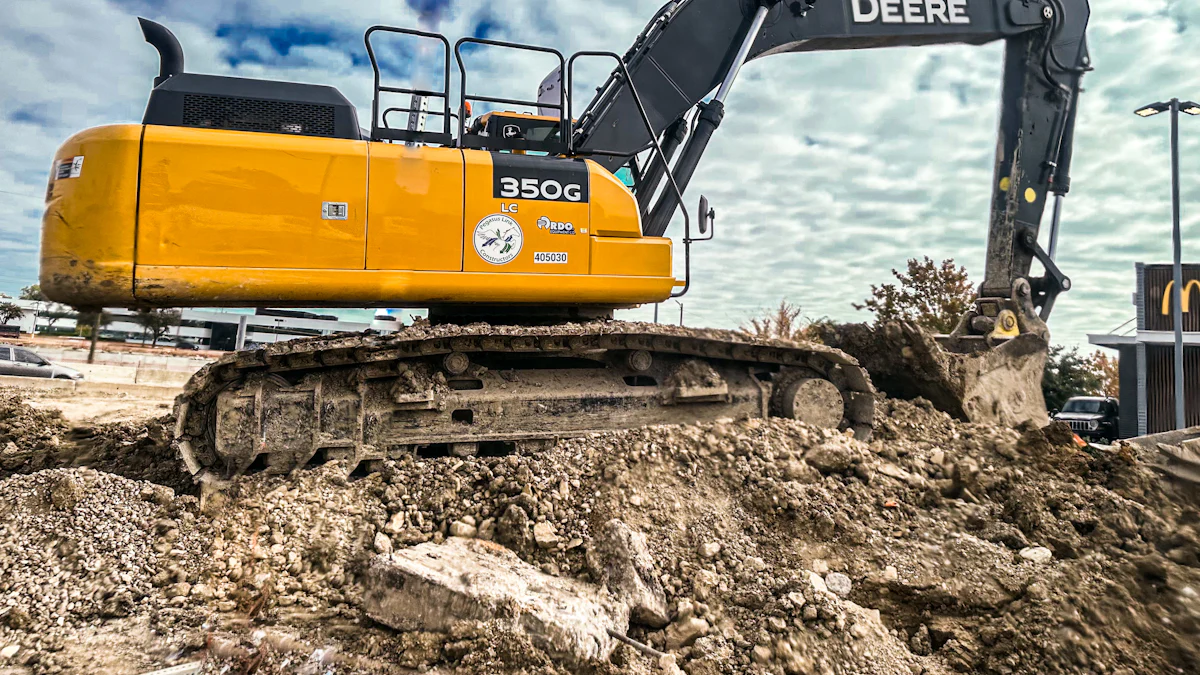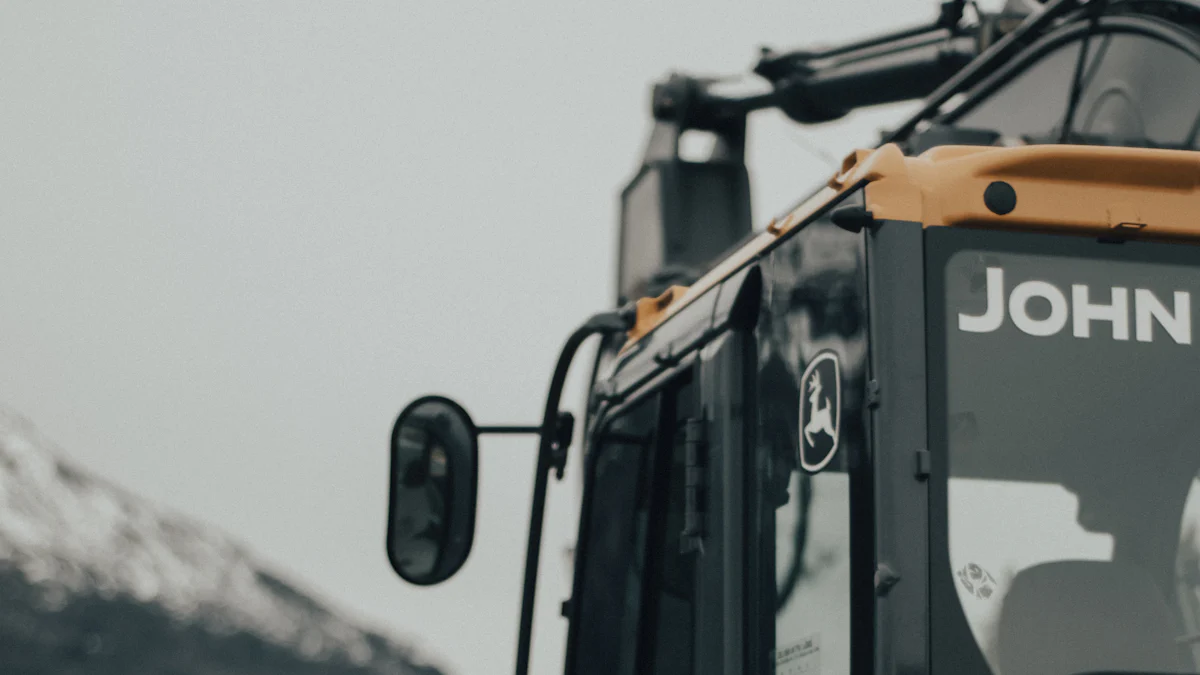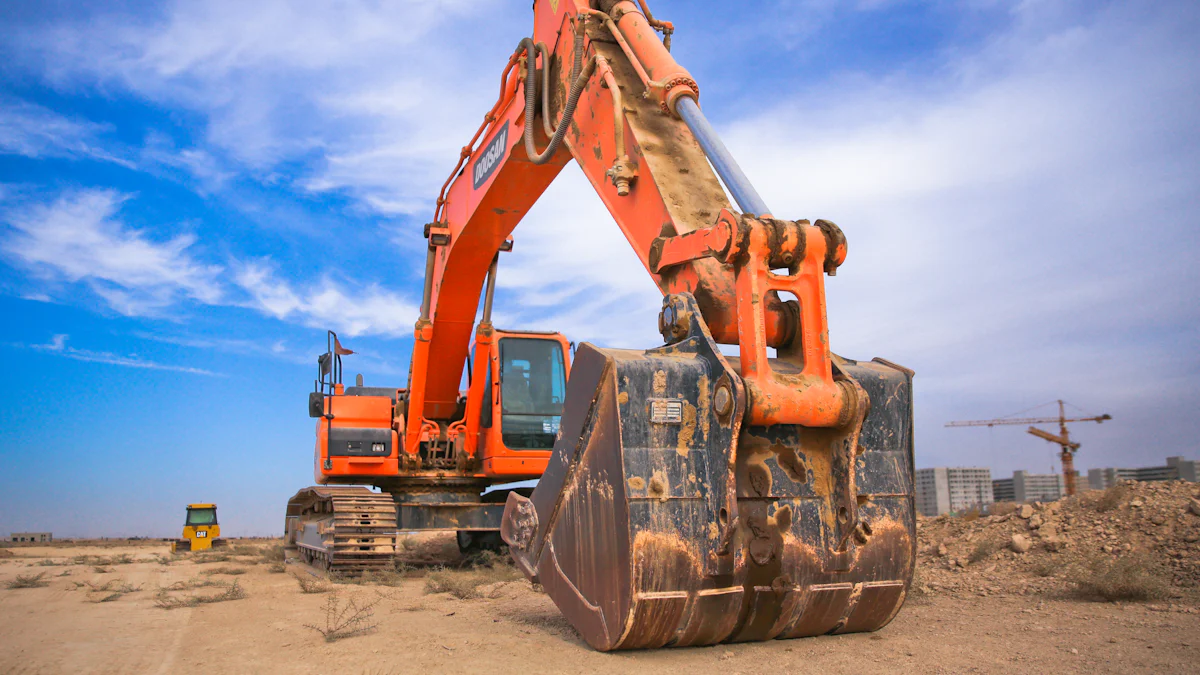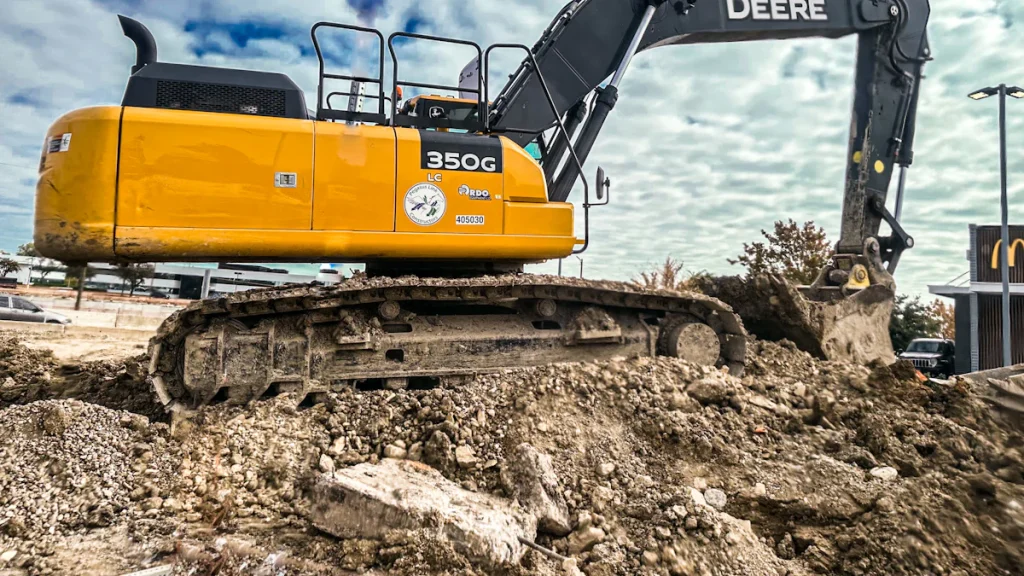
When buying John Deere excavator salvage parts, ensuring quality is essential. Low-quality parts can lead to frequent breakdowns, higher maintenance costs, and reduced equipment efficiency. High-quality salvage parts, on the other hand, help keep older machines operational while lowering replacement expenses. You should always inspect for wear, test functionality, and verify the source of the parts. Trusted suppliers like YNF Machinery provide reliable John Deere parts that extend the lifespan of your excavator and maintain its performance. Choosing the right supplier ensures durability and cost savings for your equipment.
Key Takeaways
Always check used parts for damage or wear. Look for cracks, rust, or old repairs to make sure they work well.
Make sure the parts fit by checking model and serial numbers. This helps avoid expensive fixes and delays from wrong parts.
Buy from trusted sellers like YNF Machinery. Reliable sellers give good parts and help keep your excavator working well.
Think about using OEM parts for better performance over time. They fit better and last longer than non-OEM parts.
Learn about warranties and return rules before buying. A good warranty covers problems, and easy returns make you feel safe.
Understanding John Deere Excavator Salvage Parts

What Are Salvage Parts?
Salvage parts are components removed from machinery that is no longer in use. These parts often come from equipment that has been retired due to age, damage, or upgrades. Unlike new or refurbished parts, salvage parts are not reconditioned or tested extensively. However, they can still provide excellent functionality when sourced carefully. For John Deere excavators, salvage parts offer a cost-effective way to replace worn-out components while keeping your machine operational.
Here’s a comparison to help you understand how salvage parts differ from refurbished parts:
Feature | Salvage Parts | Refurbished Parts |
|---|---|---|
Cost | Cheapest replacement parts available | More expensive than salvage parts |
Functionality | No guarantees, high risk of injury, limited support | Bench-tested, backed by a long warranty |
Availability | Broad resource, but parts may not be available | Limited availability, but often more reliable |
Environmental Impact | Environmentally friendly recycling of used parts | Environmentally friendly |
Installation | Requires tools and skills to pull parts | Can be installed by a professional at lower cost |
Benefits of Salvage Parts for Excavators
Cost-Effectiveness of the Best Used Excavator Parts
Salvage parts are among the best used excavator parts for saving money. They cost significantly less than new or refurbished components, making them ideal for budget-conscious buyers. By choosing salvage parts, you can maintain your John Deere excavator without overspending.
Environmental Advantages of Reusing Parts
Using salvage parts promotes sustainability. It reduces waste by repurposing materials that would otherwise end up in landfills. This environmentally friendly approach also minimizes the need for manufacturing new parts, conserving resources and energy.
Availability of Rare or Discontinued Components
Salvage parts provide a solution when you need rare or discontinued components. For older John Deere excavators, finding specific parts can be challenging. Salvage yards often have a wide selection, ensuring parts availability for your machine.
Additionally, some salvage parts may have low hours of use, offering reliability comparable to new components. This makes them a practical choice for maintaining your equipment.
Common Myths About Salvage Parts
Many people believe salvage parts are unreliable or unsafe. While it’s true that some parts may show wear, careful inspection and sourcing from reputable suppliers like YNF Machinery can mitigate these risks. Another myth is that salvage parts are outdated. In reality, they often include components from newer machines, providing modern solutions at a fraction of the cost. By understanding these misconceptions, you can make informed decisions when purchasing used excavator parts.
Key Factors to Consider When Choosing Salvage Parts
Ensuring Compatibility with Your John Deere Excavator
Checking Model Numbers and Serial Numbers
When selecting salvage parts, you must confirm they match your John Deere excavator’s model and serial numbers. These identifiers ensure the part will fit and function correctly. Always cross-check the numbers with the part’s documentation or consult an excavator-specific parts supplier for guidance. This step prevents compatibility issues that could lead to costly repairs or downtime.
Verifying Specifications for Excavator Engine Parts
Specifications like size, material, and performance ratings are critical when choosing engine parts. For example, if you’re replacing a crankshaft or piston, ensure the dimensions align with your excavator’s requirements. Inquire about the part’s history and hours of use to understand its previous applications. This information helps you assess whether the part will maintain your machine’s efficiency and performance.
Assessing Quality and Condition
Identifying Signs of Wear or Damage
Inspecting used excavator parts thoroughly is essential. Look for cracks, rust, or corrosion on the exterior. Examine hydraulic systems, including cylinders, hoses, and connectors, for leaks or bulges. Check pins, bushings, and sprockets for wear or deformation. Pay special attention to high-stress areas like the boom and bucket, as these often show signs of previous repairs or heavy use. A detailed inspection ensures you avoid parts that could fail prematurely.
Testing Functionality of Hydraulic Cylinder Seal Kits
Hydraulic cylinder seal kits play a vital role in preventing leaks and maintaining smooth operation. Before purchasing, test the kit’s flexibility and alignment. Ensure it meets international quality standards and fits your excavator’s specifications. A functional seal kit reduces the risk of hydraulic system failure, saving you time and money on repairs.
Sourcing from Reputable Suppliers
Why Choose YNF Machinery for the Best Used Excavator Parts
YNF Machinery stands out as a trusted supplier of John Deere parts. With over 35 years of experience, they offer high-quality components like engine parts and hydraulic cylinder seal kits. Their rigorous quality inspections ensure reliability, while competitive pricing makes them an excellent choice for budget-conscious buyers. YNF Machinery simplifies the sourcing process, providing the best used excavator parts to keep your equipment running smoothly.
Evaluating Dealer Reviews and References
Before purchasing, research the supplier’s reputation. Look for customer reviews and references to gauge their reliability. Compare prices across multiple sources to find the best deals on quality used excavator parts. Trusted suppliers, such as those within the John Deere dealer network, often provide better service and support. This step ensures you receive durable parts from a reputable source.
OEM vs. Non-OEM Salvage Parts
When choosing salvage parts for your John Deere excavator, you’ll encounter two main options: OEM and non-OEM parts. Understanding their differences helps you make an informed decision.
Advantages of OEM Salvage Parts
OEM parts, or Original Equipment Manufacturer parts, are made by the same company that built your John Deere excavator. These parts offer several advantages:
Advantage | Description |
|---|---|
Compatibility | OEM parts are designed to fit your vehicle and integrate seamlessly with its systems. |
Longer lifespan | These parts are made to the same specifications as genuine parts, ensuring reliability and durability. |
Warranty | OEM parts typically come with a warranty, providing protection against defects or malfunctions. |
OEM parts ensure high quality and compatibility. They often come with comprehensive warranties, giving you peace of mind. For example, John Deere OEM parts may include a 12-month warranty, which protects against defects. These parts also integrate perfectly with your excavator, reducing the risk of operational issues. Their durability means fewer replacements, saving you time and money in the long run.
Pros and Cons of Non-OEM Alternatives
Non-OEM parts, on the other hand, are manufactured by third-party companies. While they may seem like a cost-effective option, they come with trade-offs:
Pros:
Lower upfront cost compared to OEM parts.
Availability from various manufacturers, offering a wide range of choices.
Cons:
Quality may vary, with some parts being less durable and reliable.
Limited warranties, often ranging from 30 to 90 days.
Compatibility issues may arise, leading to potential performance problems.
Slower shipping times and harder sourcing for specific models.
Non-OEM parts can work for short-term fixes or when you’re on a tight budget. However, their lower durability and limited support make them less ideal for long-term use. Unlike OEM parts, they may not meet the same quality standards, which could lead to frequent replacements.
Choosing between OEM and non-OEM salvage parts depends on your priorities. If you value reliability and long-term performance, OEM parts are the best choice. For budget-conscious buyers, non-OEM parts might offer a temporary solution. Always weigh the pros and cons to find the best used excavator parts for your needs.
Inspection Tips for John Deere Excavator Salvage Parts

Conducting a Visual Inspection
Checking for Cracks, Rust, and Corrosion
Start by examining the part’s surface for visible damage. Look for cracks, rust, or corrosion, especially in areas exposed to moisture or heavy use. These issues can weaken the part and reduce its lifespan. Pay close attention to structural components like frames and brackets, as these are critical for maintaining your excavator’s stability. A thorough visual inspection helps you avoid parts that may fail prematurely.
Identifying Signs of Previous Repairs
Inspect the part for signs of past repairs, such as weld marks or mismatched paint. These indicators suggest the part has undergone significant stress or damage. While some repairs may not affect functionality, others could compromise the part’s reliability. Always evaluate whether the repair quality meets your standards before making a purchase.
Performing Functional Tests
Ensuring Smooth Operation of Moving Parts
Test moving parts to ensure they operate smoothly. For example, rotate gears, pulleys, or shafts to check for resistance or unusual noises. Observe the start-up condition of the part, noting the speed and any excessive smoke. Smooth operation indicates the part is in good working condition and ready for use.
Testing Electrical Components
Electrical components require careful testing. Connect the part to a power source and verify its functionality. For hydraulic systems, inspect for wear and test rams under load. Additionally, test the slew ring by rotating the cab and observing its movement after stopping. These tests confirm the part’s performance and help you identify potential issues.
Reviewing Documentation and History
Requesting Maintenance Records
Ask for maintenance records to understand the part’s history. These records provide insights into how the part was used and maintained. A well-documented history often indicates the part has been cared for properly, increasing its reliability.
Verifying the Source of Salvage Parts
Ensure the part comes from a reputable source, such as an excavator parts workshop or a trusted supplier. Verify the part’s origin and confirm it matches your John Deere excavator’s specifications. Reliable sources often provide oem parts, ensuring compatibility and quality. This step minimizes the risk of purchasing counterfeit or substandard components.
By following these inspection tips, you can confidently select the best used excavator parts for your needs. Whether you’re sourcing john deere excavator salvage parts or other used excavator parts, a thorough inspection ensures you get durable and reliable components.
Warranty and Return Policies for Salvage Parts
Importance of Warranty Coverage
Key Features to Look for in a Warranty
When buying salvage parts, you should always check if the supplier offers a parts warranty. A good warranty provides peace of mind by protecting you from unexpected defects or malfunctions. Look for warranties that cover a reasonable time frame, such as 6 to 12 months. This ensures the part will perform as expected during its initial use. Also, confirm whether the warranty includes replacement or repair options. Some suppliers may even offer extended warranties for critical components like hydraulic systems or oem parts. These features can save you money and reduce downtime.
Common Warranty Limitations to Be Aware Of
Not all warranties cover every issue. Many exclude damage caused by improper installation or misuse. Some warranties may only apply to specific parts, leaving out wear-and-tear items like seals or gaskets. You should also check if the warranty requires you to use an authorized excavator parts workshop for installation. Ignoring these limitations could void your warranty. Always read the terms carefully to avoid surprises later.
Understanding Return Policies
Flexibility in Returns for Excavator Couplings
Return policies vary widely among suppliers. Flexible policies allow you to return parts like excavator couplings if they don’t fit or meet your expectations. Look for suppliers who offer a hassle-free return process with minimal restocking fees. This flexibility ensures you won’t get stuck with unusable parts. Some suppliers even provide prepaid return labels, making the process easier for you.
Avoiding No-Return Scenarios
Some suppliers may have strict no-return policies, especially for salvage parts. To avoid this, ask about the return policy before purchasing. Reliable suppliers often allow returns for defective or incompatible parts. If a supplier refuses to accept returns under any circumstances, consider it a red flag. A clear and fair return policy reflects the supplier’s confidence in their products and commitment to customer satisfaction.
Tip: Always keep your purchase receipts and any related documentation. These records can help you claim a warranty or process a return if needed.
Prioritizing quality, compatibility, and reputable sourcing ensures you get the most value from John Deere excavator salvage parts. Trusted suppliers like YNF Machinery simplify this process by offering reliable components such as excavator engine parts, hydraulic cylinder seal kits, and excavator couplings. They evaluate part conditions and maintain high standards to ensure reliability.
When purchasing used excavator parts, always research the part’s history and hours of use. Conduct thorough inspections and compare prices across suppliers. These steps protect your investment and keep your excavator performing at its best. Make informed decisions to extend your machine’s lifespan and reduce downtime.
FAQ
What are the key benefits of using salvage parts for John Deere excavators?
Salvage parts save money and reduce waste. They provide a cost-effective solution for maintaining older machines. You can also find rare or discontinued components that are no longer available as new parts. This makes them an excellent choice for extending your excavator’s lifespan.
How can you ensure the quality of salvage parts before purchasing?
Inspect the parts for cracks, rust, or wear. Test moving components for smooth operation. Verify the part’s compatibility with your excavator by checking model and serial numbers. Always source from reputable suppliers like YNF Machinery to ensure reliability and durability.
Are OEM salvage parts better than non-OEM alternatives?
OEM salvage parts offer better compatibility and durability. They are designed specifically for your John Deere excavator, ensuring seamless integration. Non-OEM parts may cost less but often lack the same quality and reliability. Choose OEM parts for long-term performance and fewer replacements.
Can you return salvage parts if they don’t fit?
Many suppliers allow returns for incompatible parts. Check the supplier’s return policy before purchasing. Reliable suppliers, like YNF Machinery, often provide flexible return options. Always keep your receipts and documentation to simplify the return process if needed.
Why should you choose YNF Machinery for salvage parts?
YNF Machinery offers over 35 years of expertise in excavator parts. They provide high-quality components like engine parts and hydraulic seal kits. Their rigorous quality checks and competitive pricing ensure you get reliable parts that meet your needs. Their customer support simplifies the buying process.





